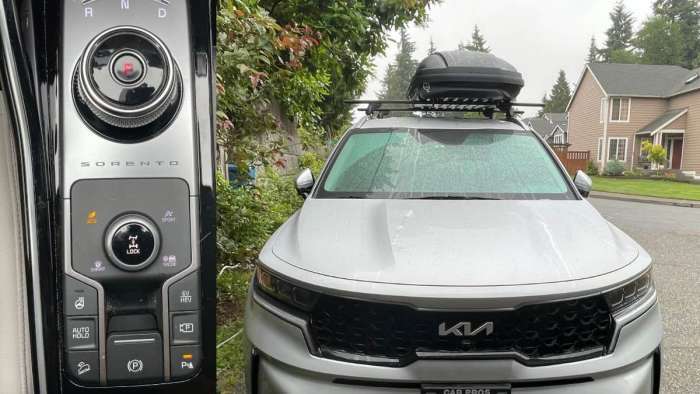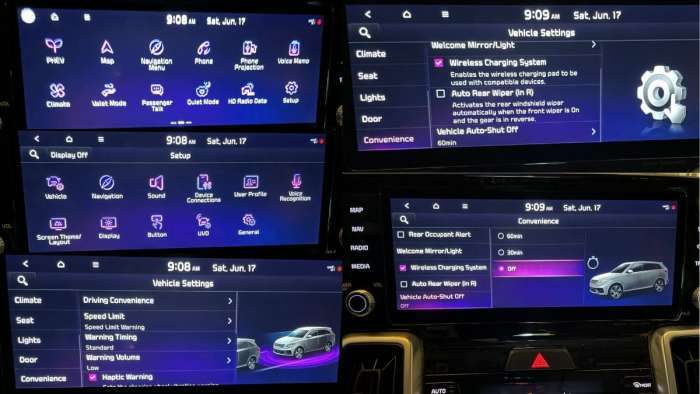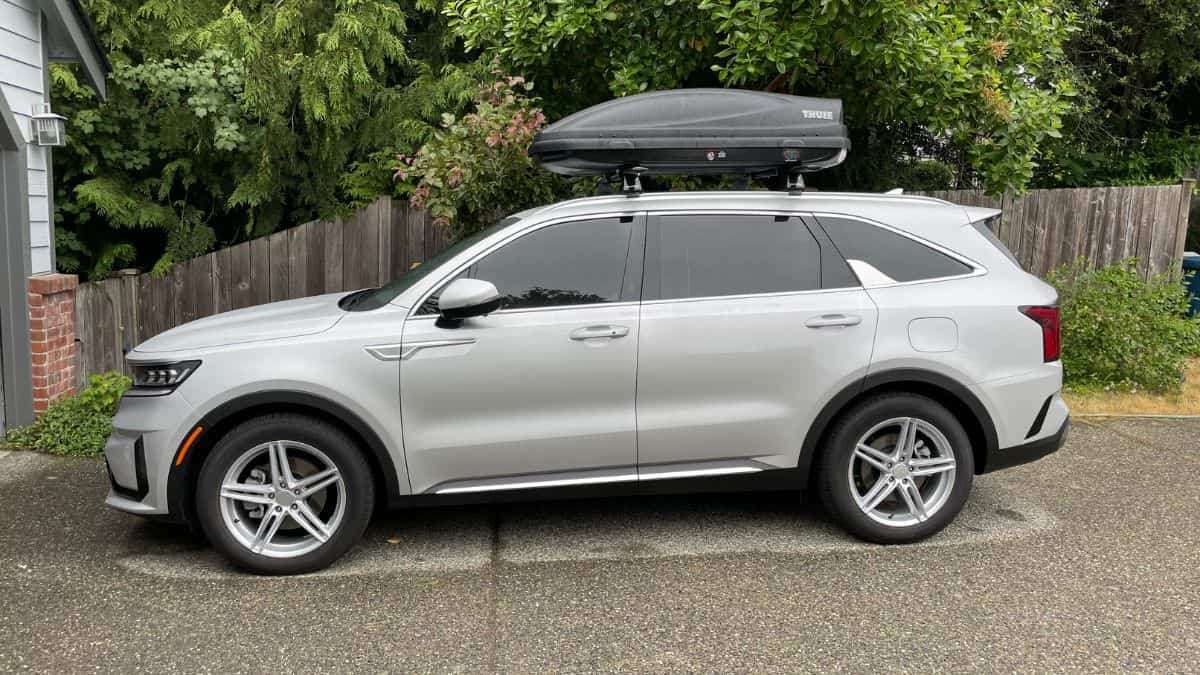I’ve written some other reviews of the Kia Sorento PHEV as a camping vehicle, pointing out our fuel efficiency, and the comfort of the vehicle for such purposes. But on this gray and misty morning, my family and I are driving about 65 miles from our home to a state park for a little rest and relaxation where the lush Pacific Northwest forest meets the deep and beautiful waters of the Puget Sound. On this trip we will to focus on some different features of our PHEV and first that will be the drive modes we are going to use to get us there. I am going to put our Kia into Smart Mode 6 miles into our trip (after I use up a bit of the hybrid battery to leave space to capture range from coasting and braking). To put the Sorento into this mode, I have to turn the smaller mode selector knob to the left, the one in front of the cup holders in the center console (see the photo below). Smart Mode allows the vehicle to actively select between Eco Mode and Sport mode based on the driver’s driving habits. In case you didn't know, Sport Mode “manages driving dynamics by automatically adjusting the steering effort, the engine, and transmission control logic for enhanced driver performance” according to Kia’s manual. More importantly, Sport Mode tends to rev the engine higher than Eco Mode (the mode intended to maximize fuel efficiency by slightly reducing accelerator response, changing transmission shift patterns, and reducing the performance of the A/C in certain situations, not that we’ll have to worry about that on this trip). Eco Mode also holds the battery’s state of charge (if/when you switch to HEV mode), unless you wait until the battery is at a low enough state of charge that it cannot power the vehicle without the assistance of the gas engine.
Anyway, those extra engine revs in Sport Mode (if they are not needed for propulsion) generate electricity and the PHEV stores it in the hybrid battery for later use and thus Sport Mode slowly recharges the battery. Some readers and people I have communicated with on social media suggest that the strategic use of Sport Mode is a means of getting better fuel economy results from your Kia PHEV, but I remain somewhat skeptical of that idea (though I do admit there is merit to it and I think it is possible given the right conditions. I think it is likely only a small difference at best and usually less efficient otherwise). But Smart Mode may put us in Sport Mode, depending, and that means a better chance of recapturing charge on our drive which makes it all the more important to leave capacity in the battery to capture it.

On this trip, I will also put the car into Auto Mode (toggled by the EV/HEV button on the right of the shifter in the Sorento, see photo above). Auto Mode simply switches between hybrid (HEV) and electric (EV) modes depending on the driving situation (if the Sorento thinks you need extra power from the gas engine due to how hard you are pressing the accelerator, speed, etc.).
UPDATE: our actual fuel efficiency on the trip to the campground was 38.2 MPG, which is not particularly inspiring considering that in December last year, in the midst of harsh winter rains, with my Sorento clad in higher rolling resistance snow tires and a bit more weighed down - though admittedly without the cargo box on the roof - I managed to get 37.6 MPG. I believe I could have gotten 1-3 miles per gallon better (or 39-42 MPG) on this current trip had I manually toggled the drive modes between HEV and EV mode. On the way home, I’ll try Sport Mode again (to give the speculation of better efficiency another test) and report back.
Also below, there are screenshots of how to disengage the vehicle auto shut-off feature (useful for when you want to power electronics like a car fridge or run the air conditioner while camping, both of which I have done for lengthy periods of time). The screenshots start in the upper left, proceed downwards and to the right, and don’t show the initial Home screen, which is the starting point from the infotainment main menu. If you have any questions or concerns, please comment below.

Images courtesy of Justin Hart.
Justin Hart has owned and driven electric vehicles for over 15 years, including a first generation Nissan LEAF, second generation Chevy Volt, Tesla Model 3, an electric bicycle and most recently a Kia Sorento PHEV. He is also an avid SUP rider, poet, photographer and wine lover. He enjoys taking long EV and PHEV road trips to beautiful and serene places with the people he loves. Follow Justin on Twitter for daily KIA EV news coverage.






Comments
Great article with the…
Permalink
Great article with the Sorento PHEV as a camper!
Question: I plan on getting the refreshed 2025 Sorento PHEV because of the big battery-- I will go with the PHEV so I can have air Conditioning/Heat while sleeping in the vehicle. With the air conditioning on, how long until the engine turns on to recharge the battery? In one hour, how often does the engine turn on and for how long? I've read that other car campers in PHEVs are able to run their air conditioning for around 6.5hrs before the engine turns on to charge the battery! Thanks and looking forward to your insight!